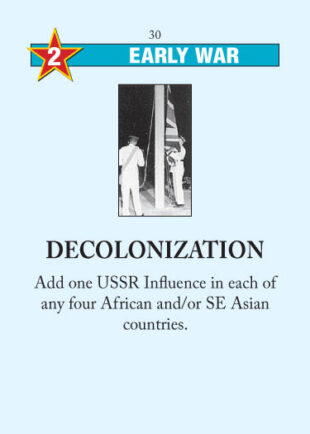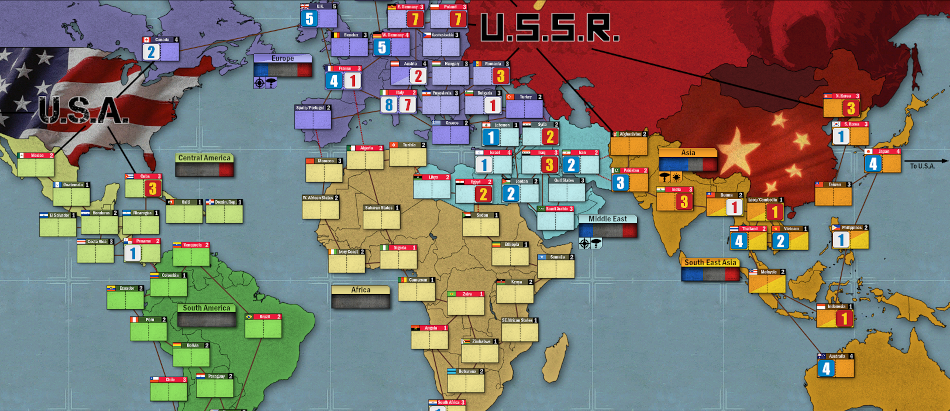This post is from Clio, who runs the Clio’s Board Games blog and Twitter account dedicated to musings on history, board games, and history in board games. He holds an M.A. in history (obtained with a thesis on the Cold War in board games) and has since then worked in the decidedly non-scholarly fields of election campaigning, the management of politics, and real estate. Clio has been a board gamer since elementary school with an ever-growing amount of gaming dedicated to historical conflicts from antiquity to the 21st century.
Below, as part of a COI “My Favorite Card” series, Clio talks about “Decolonization” from Twilight Struggle.
When Harold asked me if I wanted to write a “My Favorite Card” post, I immediately knew which card it would be about: the one that opened a world for me.
Almost ten years ago, I was a young lad just about to write my bachelor thesis in history. Its topic (the agency of the Soviet Union, Cuba, and the People’s Movement for the Liberation of Angola (MPLA) in the Angolan Civil War) touched on two issues that made up my main research interest at the time–the Cold War, and decolonization.
As I was also a board gamer already (though mainly in a euro way), I thought that decolonization would make for a fascinating board game. Surely someone had done that already? I googled “decolonization board game.” What I found was the piece about the Decolonization card in Twilight Struggle (Ananda Gupta/Jason Matthews, GMT Games) on Twilight Strategy.
Everything about that wowed me. First, a board game about the Cold War? How fascinating was that?! Then, a game that dealt with history at this level of detail? Even more fascinating! As I found out more about Twilight Struggle, exciting things from the Truman Doctrine to the Soviet war in Afghanistan popped up.

The “Decolonization” card in Twilight Struggle.
I purchased Twilight Struggle soon after and immediately began to rope all my board gaming friends into playing it with me. It soon turned out that the Decolonization card, true to its historical content, could be a real game-changer: Soviet players could often dominate Europe, or the Middle East, but had a hard time getting into Africa and the more remote regions of Asia. Decolonization solved this problem for them–and many a Soviet player who got out of the Early War with a decent lead in points and an established position in the global South has cruised to victory soon after.
The effect of the card represents a specific perspective on decolonization–that of Khrushchev’s hopes and Eisenhower’s fears that the newly independent nations would be hotbeds of Communist activity. Historically, it did not turn out that way. That’s quite in keeping with the design of Twilight Struggle. As Ananda and Jason mention in their designer notes, the game is not supposed to be a simulation, and it “accepts all of the internal logic of the Cold War as true—even those parts of it that are demonstrably false.” In other words: Twilight Struggle is less concerned with what was actually happening in the world from the 1940s to the 1980s, and more with what the superpowers thought was happening.
The photograph illustrating the card is also a representative of a particular perspective on decolonization. Soldiers lower a British flag. Thus, decolonization is a state-centric process (as everything in Twilight Struggle happens on the level of the nation-states on the board or the superpowers manipulating them), and it is one that can be planned and shaped by the countries in the global north (who, presumably, set the date for when the flag is lowered and independence given).
That was a common hope within both the colonial powers and the United States–“orderly decolonization” on amicable terms–but rarely achieved. Often, decolonization looked more like the photo “The Rapier Thief of Léopoldville” (Robert Lebeck), which shows a Congolese man triumphantly running away from the car of Belgian king Baudouin, having snatched the king’s rapier without him noticing.
Don’t get me wrong: I don’t think the mechanics or the design of the card are a weakness. On the contrary, they are a strength, because they encourage thinking about the game’s relationship with history. For me, that led to finishing my academic education with a M.A. thesis about the Cold War in board games. Of course, Twilight Struggle featured prominently.
Shortly before leaving university, I started my blog. It’s been my main outlet for my musings about history, board games, and history in board games since then. Most of the games I write about are games in the mold of Twilight Struggle–historical conflict games, often politics-focused, often card-driven. And it all began ten years ago for me–with the Decolonization card.
You can check out Clio’s blog here, and follow their Twitter here.
[Top photo of the Twilight Struggle map from the Playdek Steam app]
